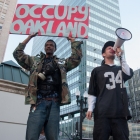After last weekend’s arrests of hundreds of people participating in the Occupy Oakland demonstration, various cross-currents seem to be roiling the group and its relationship with both city leaders and the community.
The Chronicle today reports on a split in the movement over the use of violence. Meanwhile, the battered image of the Oakland Police Department took yet another hit after multiple uses of tear-gas and the arrest and detention of a handful of local journalists.
Yesterday, KQED’s Tara Siler spoke with Susan Mernit, editor and publisher of KQED News Associate Oakland Local, to try to get a handle on why the Occupy situation has degenerated into this state of low-level internecine warfare, and where the movement stands now in terms of its place in the community. An edited transcript follows the audio.
Tara Siler
In any protest movement there’s often antagonism between protesters and police. But in Oakland the relationship seems completely toxic. What are the reasons for that?
Susan Mernit
I think that the Oakland police force has a long history of not dealing well with nonviolent citizens, dating back to the Rough Riders ten years ago. The department has been under federal observation over that. A lot of police officers are not that well-trained.
Tara Siler
You’ve been watching the movement closely; why do you think the city has had such a hard time negotiating with this particular group? And is there any hope that can be changed?
Susan Mernit
This is an octopus without a head. There are so many tentacles and so many splinter groups that it’s really hard to find who the person is to negotiate with. And while the general assembly is judged to be the governing body, many, many people in occupy are operating without ever going to a general assembly. Finding the right person who can bring consensus between Occupy and Oakland is really challenging for the city. And I think the city really isn’t sure what to ask for.
Tara Siler
What about the agenda of the movement? Beyond the familiar protests against economic inequality that characterizes the movement across the country, are there other agendas at work in occupy Oakland?
Susan Mernit
Many of the people that I know who are from Oakland who have gotten involved with Occupy have a longstanding history as community activists. At this point some of those people have peeled off and I see people who are somewhat younger and newer to Oakland at the core of the movement. I think for a lot of them Oakland is more of an operating theater then that they have an entrenched stake in the city.
Tara Siler
Do you think there’s a division in the movement over the issue of violence?
Susan Mernit
There’s an intense division. There were several efforts to pass a nonviolent resolution at the general assembly and they all failed. People now are even more conflicted because episodes of violence are happening without any authorization except by self-entitled groups. Any kind of management of violence just isn’t there.
Tara Siler
Will the ongoing violence complaints related to the Occupy protest affect the court’s oversight of the OPD?
Susan Mernit
Yes. I just read the latest study by the federal monitor, who said he was closely watching the police behavior during Occupy. There’s going to be another report released in April, and I’m expecting that will also condemn the police. They’re not supposed to make any decisions now without checking with the monitor about their plans. The plans they had published and the plans that are commonly followed – not using rubber bullets, not striking people with batons, not using tear gas – at least one of those, using tear gas, the police have acknowledged, and demonstrators have video that makes it look like they may have done the other things as well.
So there seems to be yet again a disconnect between what the written, filed plans were, and what actually happened when police were on the ground confronting demonstrators.
Tara Siler
How much alienation is there between Occupy and the rest of Oakland now?
Susan Mernit
There’s deep, deep alienation. I feel like Oakland is a city that’s being torn apart, because so many people here support the goals of Occupy Wall Street and are concerned about the impact of big banks and foreclosure on Oakland, and they feel like they’re part of the 99%. And yet many people, because of the violence and because of the transient nature of some of the people who have gotten involved in Occupy Oakland, have taken steps to distance themselves from the movement.
And with this latest incident on Saturday, especially the vandalism of city hall, a number of people who who were involved through Saturday have published things on their Facebook page and published essays saying, ‘that’s it, I’m done.’
Here is one such condemnatory essay making the rounds on Facebook by a former Occupy Oakland member, who says:
What happened in the streets of Oakland yesterday and into last night was stupid, and I no longer want to have my name associated with a “movement” that is so driven by anger at the expense of strategy…and speaks against many of my core values and principles.
